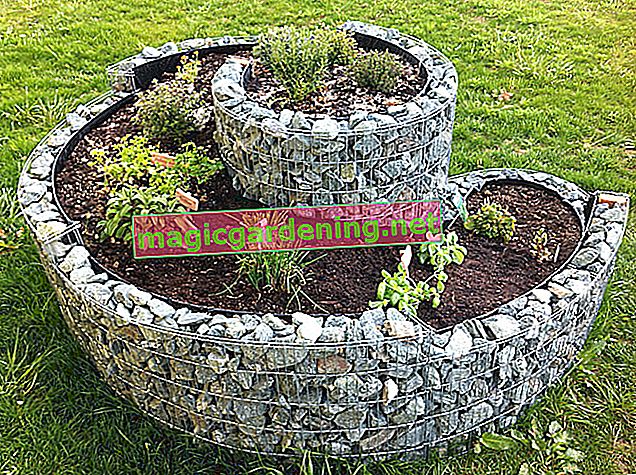
Choosing a location - tips for alignment
Choose a sunny, warm and sheltered location in the garden for your herb snail. The most popular herbal plants thrive in all their splendor where they can bathe in light and warmth. The ingenious structure as a spiral facing south creates a microclimate in which Mediterranean sun worshipers and native forest herbs feel equally at home.
also read
- Build your own garden - tips on building plans and instructions
- The ideal location for the herb snail
- Build your own herb spiral out of stones - that's how it works
Purchase of materials and tools
These construction instructions explain how you can build a herbal spiral from natural stones with a small pond yourself. The following materials and tools are required:
- Natural stones (at least as thick as a fist)
- Gravel, crushed stone and sand
- Herbal soil or garden soil, compost
- wheelbarrow
- Shovel, rake, cultivator, hand shovel
- Wooden pegs, cord
- Watering can
- Herbal plants
- Pond liner or pond tub
Use these instructions as inspiration to realize your individual design plans. There are various alternatives to choose from for the design of the frame. Do you have a weakness for modern garden design? Then give the herb spiral a stylish shape with stone-filled gabions. Bargain hunters use bricks or clinker for the spiral wall.
Prepare the base correctly - this is how it works
So that at least 10 to 12 of your favorite herbal plants find space in the spiral, the area should be generously dimensioned. For a height of 80 cm and a diameter of 300 cm, please reserve an area of around 7 square meters in your garden. Mark the floor plan with cords and wooden pegs so that a snail shape is created that opens to the south. These instructions summarize how you can easily do the preparations yourself:
- Stick a long wooden stick into the ground in the center of the area
- Attach a cord with a knotted wooden stick and draw a circle
- Mark a spiral with 2 to 3 turns inside the circle by sprinkling lime or light-colored sand
- Dig the garden soil deep into the ground
- Spread out an approximately 10 cm thick layer of gravel as a foundation for the wall and drainage against waterlogging
Where the herb spiral opens to the south, mark the position for the small pond, which you will also build yourself. At this point, excavate the soil about 40 cm deep in order to later lay out pond liner or use a pond tub. A ballast layer is not used here.
Build drywall yourself - building instructions
For the construction of a dry stone wall, the natural stones are staggered and stacked without mortar. For the first row of walls, please use the largest stones that you lay on the gravel foundation along the marking. Each subsequent layer ends 50 cm earlier than the previous stone layer. Proceed in this way until the herb spiral has reached a height of 80 cm.
Wherever there are larger joints, you can later add more herbs with the help of plant bags. This horticultural trick increases the planting area, provides additional stability within the drywall and beautifies the appearance of your herb spiral. Numerous beneficial insects in the garden will appreciate the hiding places.
Filling the herb spiral correctly - this is how it works in the DIY process
An authentic herbal spiral extends over various moisture zones and areas of life. Mediterranean, sandy-dry conditions prevail in the upper region. The middle area is reserved for herbs that prefer partially shaded, moderately humid areas. The base with mini pond is reserved for shade-tolerant, water-loving herbs. With the correct filling, you can take these requirements into account. That is how it goes:
- Fill the herb spiral in stages from the inside out
- Center: Mixture of garden soil and sand in a ratio of 1: 1
- Middle area: one third each of garden soil, compost and sand
- Basis: garden soil and compost in equal parts
At the lower end of the herb spiral, fill the pond hollow with a 5 cm layer of sand. Lay the pond liner on top or insert the pond tub. You can hide the edge of the small water world with natural stones or gravel. Distribute nutrient-rich herb or garden soil as a substrate for the shore zone. If the water is poured in here, the perfect environment for watercress and other marsh herbs is created.
Skillfully planting herb snails - tips for the planting plan
Allow about 14 days to pass before you plant your herb spiral to allow the soil to settle. We have put together these tips for your planting plan for varied planting:
Upper, Mediterranean zone:
- Provence lavender (Lavandula x intermedia)
- Marjoram (Origanum majorana)
- Rosemary (Rosmarinus officinalis)
Middle, temperate zone:
- Lemon balm (Melissa officinalis)
- Chives (Allium schoenoprasum)
- Tarragon (Artemisia dracunculus)
Pond zone:
- Water hazel (Trapa natans)
- Watercress (Nasturtium officinale)
- Water mint (Mentha aquatica)
Tips
When you plant garden herbs, the location is not all that matters. By no means all types of herbs are good neighbors. Marjoram and thyme are at war. The dream teams in the herb kingdom include fennel, coriander, tarragon and thyme. Dill, parsley and marjoram harmonize wonderfully with the annual herbs.








